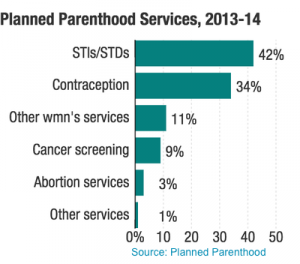 If you didn’t watch it, then you may have heard the clips or perhaps viewed the mansplaining vine that characterized the mean-spirited and prosecutorial tone of the September 29th House Oversight and Government Reform Committee’s five-hour grilling of Planned Parenthood President Cecile Richards. In September, amid rumors of staffers profiting from selling fetal tissues and a flurry of purportedly incriminating video content, Congress voted 241-to-187 to strip Planned Parenthood of some $500 million in federal family planning funds for a year. Women’s reproductive health remains a deeply political issue.
If you didn’t watch it, then you may have heard the clips or perhaps viewed the mansplaining vine that characterized the mean-spirited and prosecutorial tone of the September 29th House Oversight and Government Reform Committee’s five-hour grilling of Planned Parenthood President Cecile Richards. In September, amid rumors of staffers profiting from selling fetal tissues and a flurry of purportedly incriminating video content, Congress voted 241-to-187 to strip Planned Parenthood of some $500 million in federal family planning funds for a year. Women’s reproductive health remains a deeply political issue.
Planned Parenthood provides women’s health services that span beyond constitutionally- protected abortion services to include contraceptives like the Pill or LARCs (long-acting reversible contraceptives), screening for sexually transmittable diseases and infections, cancer screenings, and treatments for other women’s health issues, all of which represented 97 percent of the services delivered in 2013-14 – according to their own reporting. However, it’s pointless to get stuck trying to make an apolitical argument that the non-abortion services provided by Planned Parenthood justifies their continued public funding, because all of Planned Parenthood’s services bear the same end goal of empowering women to take control of their sexual and reproductive lives — and that’s the part that is inescapably political. It’s disingenuous to say this is about the law or fetal tissue or video or the sanctity of life or anything other than what it is: the agency of women. 
Research demonstrates that empowerment through expanding access to and use of subsidized birth control reduces abortion rates and helps more women avoid unplanned births, so spending on contraception more than pays for itself. Fifty years of access to birth control and increased reproductive health has brought about a 60 percent decrease in adolescent birth rates since 1991 (Future of Children), which is good news when we calculate the social costs of unprepared or premature parenting. However, the U.S. adolescent pregnancy rate remains the highest in the developed world (at 57 per 1,000 in 2010) outside the former Soviet Bloc (Guttmacher Institute). A recent policy brief from the Future of Children argues that the increased access to LARCs could play a major role in reducing adolescent pregnancy, although only about 12 percent of women aged 15–44 using birth control use them. The authors suggest “LARCs are effective in large part because they change the default for women from having to take action to avoid pregnancy (that is, consistently take a pill or use a condom) to having to take action to become pregnant (that is, remove an IUD or an implant).”
Last week in Colorado, a bill to continue funding of a program to promote the use of LARCs was blocked by the Republican-dominated Senate – some opponents claimed that existing public programs already provide funding for birth control, that birth control encourages sex among teenagers and unmarried young adults, and that abstinence only programs are the most appropriate programs for teens. The most seditious and misguided claim was that the particular LARC to be funded by the bill (the intrauterine device [IUD] Liletta) is an abortifacient – meaning that it works by terminating a pregnancy. This claim does not hold up to scientific scrutiny, nor does it fit with the definition widely accepted by experts, including the American College of Obstetricians and Gynecologists, which explicitly states in a position paper “IUDs are not abortifacients—they work before pregnancy is established—and are safe for the majority of women, including adolescents and women who have never had children.”
Dressing down Planned Parenthood and blocking access to legal, affordable, safe, and constitutionally protected birth control are not the only facets of the disempowerment strategy. The Department of Health and Human Services’ Teen Pregnancy Prevention Initiative (TPPI), which awards five-year grants to teen pregnancy prevention programs, recently announced that additional funding will be committed to new programs in 31 states this year, but the remaining four years are in jeopardy. Last summer, the Senate Appropriations Committee voted to cut funding to the program by 80 percent, and the House Appropriations Committee voted to terminate it altogether.
Like the crusade to defund Planned Parenthood, the resistance to providing access to all forms of women’s reproductive health services is a misguided mission. The transparent and mendacious attacks on women’s autonomy proves to be less focused on protecting the sanctity of human life or fetal tissue, or videos, or legal requirements, than on penalizing women for having non-reproductive sex or empowering them to have greater control over their lives. Margaret Sanger, the founder of Planned Parenthood and a tireless advocate for a woman’s right to control her own body, said “woman must have her freedom, the fundamental freedom of choosing whether or not she will be a mother and how many children she will have. Regardless of what man’s attitude may be, that problem is hers – and before it can be his, it is hers alone.” And so goes the politics of the women’s bodies with a white-hot heat.
Perry Threlfall is a recent graduate of the doctoral program in sociology at George Mason University. She studies gender, racial, and class stratification across institutional and structural contexts, e.g. education and family. Her current research examines the contextualized experience of non-traditional higher education degree seekers. You can read her occasional blog at the Single Mother Sociologist.

Comments